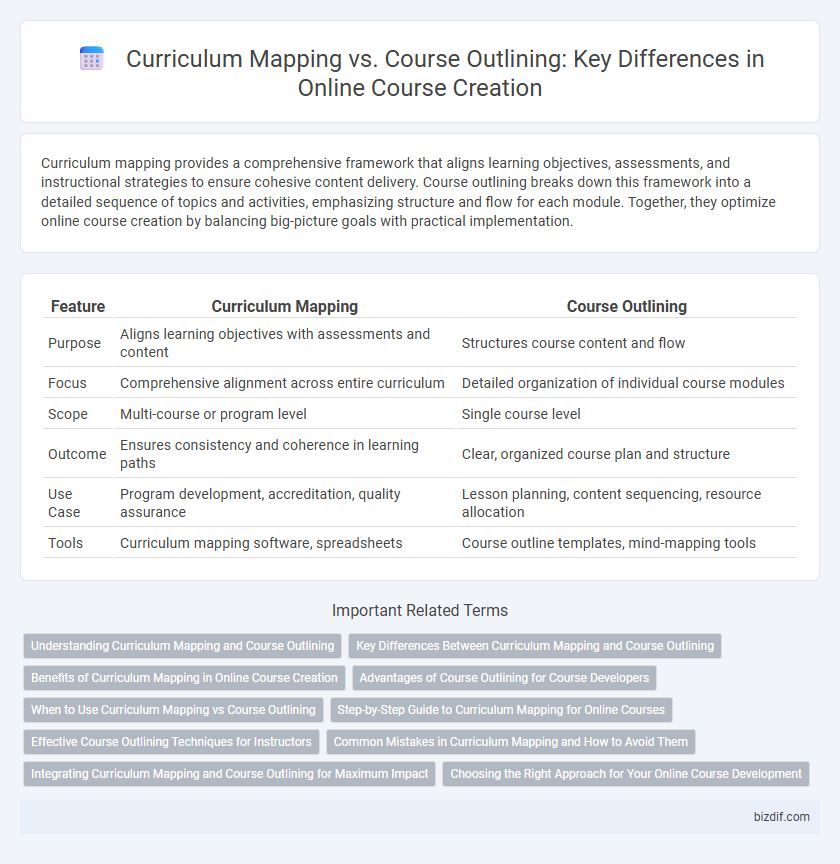Curriculum mapping provides a comprehensive framework that aligns learning objectives, assessments, and instructional strategies to ensure cohesive content delivery. Course outlining breaks down this framework into a detailed sequence of topics and activities, emphasizing structure and flow for each module. Together, they optimize online course creation by balancing big-picture goals with practical implementation.
Table of Comparison
| Feature | Curriculum Mapping | Course Outlining |
|---|---|---|
| Purpose | Aligns learning objectives with assessments and content | Structures course content and flow |
| Focus | Comprehensive alignment across entire curriculum | Detailed organization of individual course modules |
| Scope | Multi-course or program level | Single course level |
| Outcome | Ensures consistency and coherence in learning paths | Clear, organized course plan and structure |
| Use Case | Program development, accreditation, quality assurance | Lesson planning, content sequencing, resource allocation |
| Tools | Curriculum mapping software, spreadsheets | Course outline templates, mind-mapping tools |
Understanding Curriculum Mapping and Course Outlining
Curriculum mapping systematically aligns learning objectives, assessments, and instructional activities to ensure comprehensive coverage across a program, enhancing coherence and skill progression. Course outlining involves structuring individual lesson plans or modules within a course, detailing specific topics, resources, and timelines for effective delivery. Understanding these processes enables educators to design courses that are both aligned with broader educational goals and structured for clarity and student engagement.
Key Differences Between Curriculum Mapping and Course Outlining
Curriculum mapping provides a comprehensive framework that aligns learning objectives, assessments, and instructional strategies across an entire program, ensuring coherence and progression over time. Course outlining focuses on designing the specific content, sequence, and structure of an individual course, detailing topics, learning activities, and deadlines. The key difference lies in curriculum mapping addressing macro-level alignment across multiple courses, while course outlining targets micro-level organization within a single course.
Benefits of Curriculum Mapping in Online Course Creation
Curriculum mapping enhances online course creation by providing a clear alignment between learning objectives, assessments, and instructional activities, ensuring a cohesive and targeted educational experience. It allows educators to identify content gaps and overlaps, promoting comprehensive coverage and efficient resource allocation. Implementing curriculum mapping results in improved learner outcomes through structured progression and measurable skill development.
Advantages of Course Outlining for Course Developers
Course outlining offers course developers a clear framework to organize content sequentially, enhancing the learning flow and student comprehension. It streamlines the development process by breaking down complex subjects into manageable sections, allowing for focused content creation and effective time management. This structured approach facilitates easier updates and customization, ensuring courses remain relevant and aligned with learning objectives over time.
When to Use Curriculum Mapping vs Course Outlining
Curriculum mapping is ideal for educators designing comprehensive academic programs, ensuring alignment of learning objectives, assessments, and instructional strategies across multiple courses. Course outlining is best suited for developing individual course content, organizing topics, and sequencing lessons for clear student progression. Use curriculum mapping during program planning phases and rely on course outlining when preparing detailed lesson plans or specific course structures.
Step-by-Step Guide to Curriculum Mapping for Online Courses
Curriculum mapping for online courses involves systematically aligning learning objectives, content, assessments, and instructional strategies to ensure cohesive and targeted course delivery. This step-by-step guide emphasizes identifying key competencies, organizing content modules, and linking assessments directly to learning outcomes to optimize student engagement and learning effectiveness. Unlike course outlining, curriculum mapping provides a comprehensive framework that promotes consistency and instructional alignment across the entire online course.
Effective Course Outlining Techniques for Instructors
Course outlining involves structuring course content into clear, manageable segments that guide learners through the material logically and progressively, enhancing knowledge retention and engagement. Effective course outlining techniques include defining specific learning objectives, organizing topics into coherent modules, and incorporating diverse teaching methods such as multimedia and assessments to address various learning styles. This method contrasts with curriculum mapping, which aligns course content with program-wide goals, making course outlining crucial for instructors to design focused and impactful learning experiences.
Common Mistakes in Curriculum Mapping and How to Avoid Them
Common mistakes in curriculum mapping include lack of clear alignment between learning objectives and assessments, resulting in gaps or redundancies in the course content. To avoid these errors, ensure each module explicitly connects objectives, instructional materials, and evaluation methods while regularly reviewing for coherence. Employing digital tools for curriculum mapping streamlines updates and maintains consistency throughout the online course development process.
Integrating Curriculum Mapping and Course Outlining for Maximum Impact
Integrating curriculum mapping with course outlining enhances course coherence and alignment by clearly defining learning objectives and linking them to specific course activities and assessments. Curriculum mapping identifies gaps and redundancies across the entire program, while course outlining focuses on detailed lesson plans within individual modules, ensuring consistent content delivery. This combined approach improves student engagement and outcomes by providing a structured, well-sequenced learning path aligned with institutional goals.
Choosing the Right Approach for Your Online Course Development
Curriculum mapping provides a comprehensive framework that aligns learning objectives, content, and assessments across an entire online course, ensuring cohesion and clear educational pathways. Course outlining focuses on structuring specific modules or lessons, detailing topics, activities, and resources for efficient content delivery. Choosing between curriculum mapping and course outlining depends on whether you need holistic curriculum alignment or targeted lesson planning to optimize your online course development.
Curriculum Mapping vs Course Outlining Infographic

 bizdif.com
bizdif.com